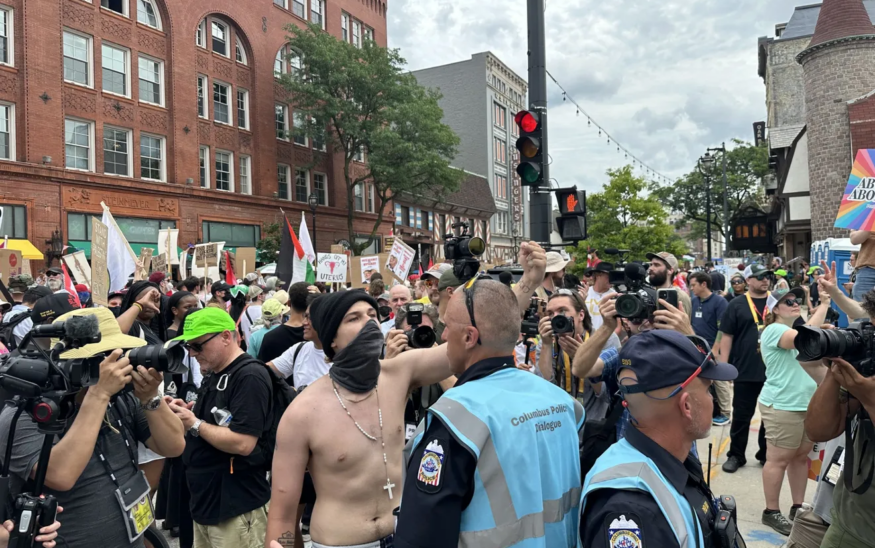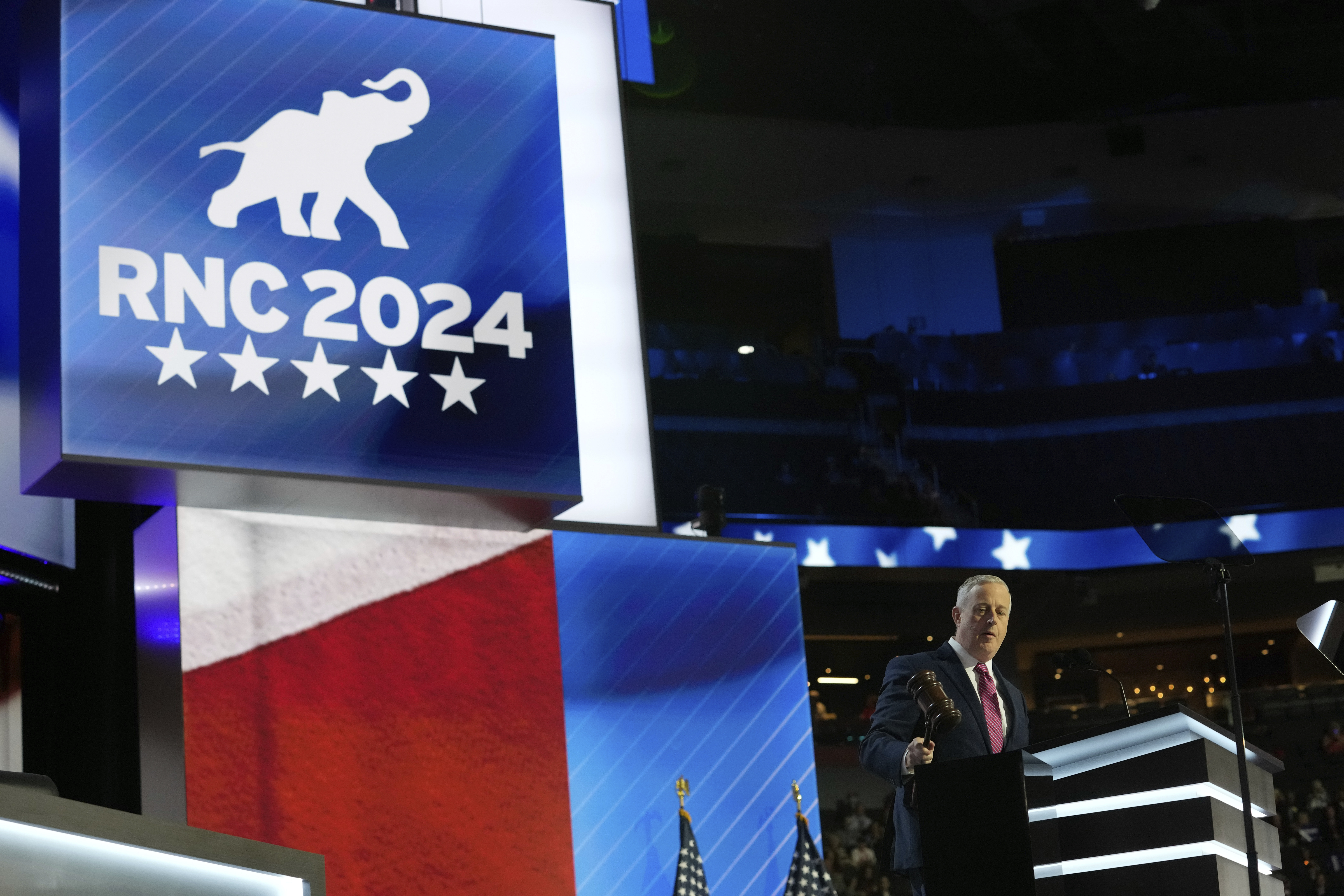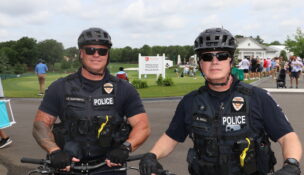A ‘police dialogue team’ from Ohio is facilitating peaceful protests during the RNC. Here’s how.
By: Bridgetower Media Newswires//July 16, 2024//
A ‘police dialogue team’ from Ohio is facilitating peaceful protests during the RNC. Here’s how.
By: Bridgetower Media Newswires//July 16, 2024//
By John Diedrich and Alison Dirr
As a long-anticipated march against the Republican National Convention stepped off Monday, a group of police officers in baby-blue vests could be seen casually walking alongside the protesters.
They weren’t from the Milwaukee Police Department. And they weren’t ordinary officers.
They came from the Columbus Police Department, a 13-member “Police Dialogue Team” that was formed a couple of years ago to approach protests differently. The goal is to facilitate people’s demonstration rights while avoiding the kind of violent conflict with police that marked the 2020 protests.
The approach, which has been employed in Europe for years, is just getting started in the U.S. with the Ohio police department among others.
Monday’s march on the RNC was the biggest test — and biggest stage — in the U.S. so far for a police dialogue team approach.
Tensions rose several times during Monday’s march through sweltering streets, as counter-protesters confronted the marchers at several spots, but the flashpoints didn’t boil over. Each time, members of the Columbus Police Dialogue Team seemed to be in the middle of the fray, calmly and politely talking to the people on both sides, de-escalating tensions.
Milwaukee police and officers from other cities were positioned along the route, but several feet off the street in more passive positions. They certainly could have reacted if needed, but in the end were largely just observers.
There surely were several factors contributing to the mostly incident-free march: coordination between the organizers and the city on the route; months of planning and training; and the presence of march facilitators, people who were part of the march but wore fluorescent vests and helped direct the crowd. And at times, those facilitators intervened with protests when things got hot.
Perhaps the biggest test came as the protest stopped on North Martin Luther King Drive and West Highland Avenue, within sight of the Fiserv Forum, the main RNC venue. A group of anti-abortion protesters were positioned just feet away. Both sides were screaming at each other.
Columbus police dialogue team officer Carl Harmon and fellow officers made sure there was a space on the sidewalk between the groups. And then they stepped in, gently, when tensions rose.
When a shirtless young man shouted profanities at the anti-abortion protesters, a Columbus police officer simply stood in front of him. The officers are still armed and command respect even with the smile on their faces.
“We aren’t here to arrest anyone. We are here to protect everyone’s First Amendment rights. It’s about talking to people,” Harmon said.
Get the News from Now newsletter in your inbox.
Top headlines from the suburbs delivered to your inbox twice a week
“We are here to protect their right. And their rights,” the Marshfield, Wis., native said, pointing his hand in one direction and then the other.
City Attorney Evan Goyke on Monday evening called the Coalition to March on the RNC protest “extremely smooth and safe.”
“I was really pleased with everyone, I think globally,” said Goyke, who observed the march on the first day of the Republican National Convention.
“We had protesters and counter-protesters,” he said. “Everyone that was here seemed well-organized, there was communication, law enforcement were everywhere they needed to be communicating with individuals.”
Goyke said he and his staff would continue to monitor situations where people are expressing their First Amendment rights during the RNC.
He also said he spoke with members of the Columbus Police Dialogue Team and is interested to see if Milwaukee police could pursue creating a similar team.
“It’s a special team with training and background to go into protests or potential civil unrest, this kind of emotion-filled environment, and I thought they did a great job today,” he said.
Communication ahead of time helped ensure everyone was on the same page, Goyke said.
Experts on policing protests and mass demonstrations have said communication is the most effective tool officers have.
New idea of protest policing started in Sweden
The idea of a police dialogue team goes back 20 years and has been used in Sweden, England and other countries. Police departments in the U.S. have become interested in the strategy, especially after heavy criticism of police responses to nationwide protests for racial justice in 2020.
Milwaukee doesn’t have such a team but is interested in the concept and asked Columbus to send its team for the RNC. The architect of Columbus’ team, a British sociology professor named Clifford Stott, was on hand Monday to see the team in action.
“This is such a breakthrough,” Stott said in an interview. “I am fantastically grateful to the Milwaukee Police Department for taking this step and putting this unit on a national stage for this very high-profile event that shows it can work in the American context.”
For now, the team is not scheduled to be at the DNC in Chicago, Stott said.
The Journal Sentinel had reached out to Stott in late June, but he declined an interview at the time because his RNC work with the Milwaukee Police Department was not confirmed.
The concept of a different police approach to protests grew out of an event years ago in Europe where a protester was killed by police. For years, police in Europe also have struggled with violence at soccer matches.
Stott said after studying the science of human behavior in group events, it was clear a different approach would help. A major component is developing trust and communication. In the case of Monday’s march, that happened beforehand.
A group of roughly 500 people marching toward a highly secured area — just days after an attempted presidential assassination attempt no less — had the potential to set off the police standing guard or the protesters moving in.
“There has to be quite a lot of re-assurance that there is not an actual intention to breach the barriers, and to have dialogue and walking in the crowd, that can help feed that information to make better command decisions,” he said.
As protesters returned to Red Arrow Park, a Trump supporter confronted them. Harmon quickly spoke to him and the man retreated. Then, in the park, marchers faced another group of anti-abortion protesters.
The march facilitators formed a line directing protesters around the counter-protestors as the Columbus officers stood by.
Sgt. Kolin Straub, who heads the Columbus Police Dialogue Team, calmly pointed to the two groups yelling at each other about abortion. Rather than seeing a problem, he saw people exercising their rights.
“This is just a crowd. These are rational people,” he said.
This article originally appeared in the Milwaukee Journal Sentinel and was republished with permission.
Legal News
- A ‘police dialogue team’ from Ohio is facilitating peaceful protests during the RNC. Here’s how.
- Project 2025 defended at Milwaukee event
- Caution surrounds firm’s AI usage
- How Hmong women in Wisconsin are tackling domestic violence in their communities
- Beloit School District rescinds scholarship’s racial eligibility criterion following WILL’s legal threat
- Day One RNC: Trump taps VP; protests erupt during nomination
- Law enforcement from Tulsa to Maryland and North Carolina volunteer to assist during RNC
- Republicans are gathering in Milwaukee to nominate Donald Trump again. Here’s what to expect
- Wisconsin election officials tell clerks best ways to operate absentee ballot drop boxes
- Family vows during funeral to push for charges after Black man pinned to ground outside Milwaukee hotel
- Melania Trump will attend the Republican convention in a rare political appearance, AP sources say
- Wisconsin officials react to President Trump’s attempted assassination
Case Digests
- Absentee Ballot Drop Boxes
- Separation of Powers- Legislative Oversight of Executive Actions
- Notice of Recommitment and Involuntary Medication Hearings
- Firearm Possession-Sufficiency of Evidence
- Motion for Substitute Counsel
- Jury Instructions
- Equal Credit Opportunity Act
- Fourth and 14th Amendment Rights-Parental Medical Neglect
- Eminent Domain
- Intrusion Upon Seclusion Claim-§1983 claim
- Employment Law- Title VII
- Employment Law












